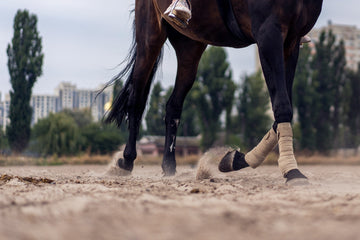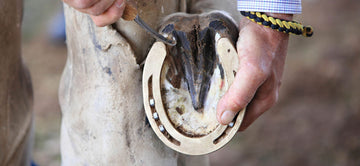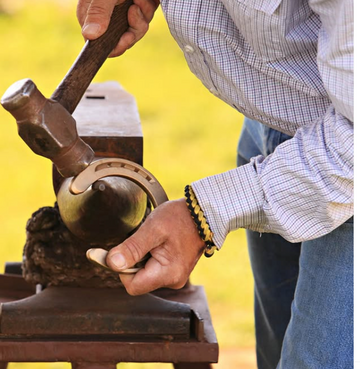Equine rain rot, also known as rain scald or dermatophilosis, is a common skin infection in horses caused by the bacterium Dermatophilus congolensis.
While not life-threatening, it can be uncomfortable and unsightly for your horse if left untreated. This guide provides a detailed overview of rain rot, including its causes, symptoms, prevention, and effective home remedies.
Understanding Rain Rot in Horses
Rain rot is a bacterial infection that thrives in damp, humid conditions. The bacterium Dermatophilus congolensis becomes active when exposed to moisture, leading to lesions and scabs on the horse’s skin.
Rain rot most commonly affects areas such as the topline, rump, face, and legs. The condition is especially prevalent during wet seasons or in climates with high humidity. Horses with long winter coats are at a higher risk, as the moisture can become trapped close to the horse's skin.
Regular full-body examinations are critical to identifying rain rot early. Catching the condition in its initial stages allows for quicker and more effective treatment.
Symptoms and Causes of Rain Rot
Symptoms of Rain Rot
Recognizing the signs of horses rain rot is essential for prompt treatment:
-
Patchy Hair Loss: Rain rot often causes clumps of hair to fall out, leaving bald patches.
-
Scabs and Crusts: Raised bumps or crusts may form on the skin, indicating the presence of infection.
-
Itchiness or Discomfort: Some horses may scratch or exhibit signs of irritation.
Causes of Rain Rot
Rain rot is primarily caused by prolonged exposure to wet conditions. Common triggers include:
-
Wet Weather: Persistent rain and high humidity create an ideal environment for bacterial growth.
-
Muddy or Wet Stalls: Horses kept in damp or unsanitary conditions are at higher risk.
-
Poor Skin Health: Stress, poor nutrition, or underlying health issues can weaken the skin’s natural defenses.
Other contributing factors include hot, humid weather, inadequate grooming, and bites from flies or other insects that break the skin.
Mud fever is another condition caused by prolonged exposure to wet and muddy environments, leading to painful scabs and sores on the legs. Proper management and hygiene practices are essential to prevent and treat mud fever.

How to Prevent Rain Rot in Horses
Hygiene and Grooming
Rain rot prevention is crucial for maintaining good hygiene practices and overall horse health:
-
Regular Grooming: Brush your horse daily to remove dirt, loose hair, and debris.
-
Frequent Bathing: Use gentle, antibacterial shampoos to cleanse the skin and keep it healthy.
Environmental Management
Reducing your horse’s exposure to damp or muddy conditions minimizes the risk of rain rot:
-
Provide Shelter: Ensure horses have access to a barn or covered area during heavy rainfall.
-
Control Mud: Use sand or gravel in high-traffic areas to prevent muddy conditions.
Fly and Insect Control
Flies and biting insects can spread bacteria and exacerbate skin infections:
-
Use Fly Sprays: Apply repellents to protect your horse from insect bites.
-
Install Fly Control Systems: Fans, traps, and sprays can reduce insect populations around your barn.
Managing Rain Rot in Horses
Immediate Steps for Affected Horses
If your horse develops rain rot, quick action can prevent the condition from worsening. For an infected horse, immediate steps are crucial to manage the infection effectively:
-
Minimize Moisture: Keep the horse dry by providing a clean, padded stall away from rain and mud.
-
Inspect Daily: Check your horse’s skin regularly to monitor the infection and identify any changes.
Supporting Skin Health
Healthy skin acts as a natural barrier against infections:
-
Improve Nutrition: Provide a balanced diet rich in vitamins and minerals that support skin health.
-
Manage Stress: Reduce stressors that could weaken your horse’s immune system.

Home Remedies for Rain Rot
Treating rain rot at home is often effective with the right horse products and practices:
Antimicrobial and Antifungal Shampoos
-
Use medicated shampoos containing povidone-iodine or chlorhexidine to cleanse the affected area.
-
Bathe the horse every 2-3 days during treatment, ensuring the skin is thoroughly dried afterward.
Topical Treatments
Natural remedies can also promote healing and reduce inflammation:
-
Propolis Cream: Known for its antibacterial properties, propolis helps heal lesions.
-
Aloe Vera Gel: Soothes irritated skin and aids in regeneration.
-
Tea Tree Oil: Acts as an antimicrobial to combat infection.
Natural Solutions
Some horse owners find success using household items:
-
Apple Cider Vinegar: Dilute with water and apply as a rinse to reduce bacterial growth.
-
Listerine: The antiseptic properties in this mouthwash can help clear up mild cases of rain rot.
Recovery and Management
Post-Treatment Care
Recovery from rain rot requires diligent care to ensure the infection doesn’t return:
-
Daily Grooming: Brush the horse gently to remove loose hair and scabs.
-
Check Blankets: If using a blanket or sheet, remove it daily to inspect the skin and wash the blanket regularly.
Long-Term Management
Maintaining a clean and dry environment is crucial for preventing future outbreaks:
-
Sheltered Turnout: Provide access to clean, dry pastures or paddocks.
-
Monitor Skin Health: Regularly inspect your horse for early signs of skin irritation.
Common Mistakes to Avoid
-
Leaving Rain Rot Untreated: Neglecting rain rot can lead to severe complications such as cellulitis, systemic infection, and significant discomfort.
It is crucial to distinguish conditions that resemble rain scald, such as rain rot, to ensure proper treatment through diagnostic tests like skin scrapings and biopsies.
-
Using Harsh Products: Abrasive cleaners or unapproved treatments may irritate the skin further.
-
Ignoring Environmental Factors: Continuing to expose your horse to wet or muddy conditions can hinder healing and lead to recurring infections.
Keeping Your Horse’s Skin Healthy
Preventative measures can go a long way in keeping your horse’s skin surface healthy:
-
Shelter: Protect your horse from prolonged exposure to rain and mud.
-
Insect Control: Regularly use fly sprays and manage biting insects around the barn.
-
Nutrition: A well-balanced diet supports overall skin health and strengthens immunity.
Frequently Asked Questions
How to treat rain rot in horses naturally?
Natural remedies like apple cider vinegar and tea tree oil can help reduce bacteria and promote healing.
Does apple cider vinegar help rain rot in horses?
Yes, apple cider vinegar’s antimicrobial properties make it a popular home remedy for rain rot.
What is the best stuff for rain rot?
Medicated shampoos with chlorhexidine or povidone-iodine are highly effective for treating rain rot.
Is Listerine good for rain rot on horses?
Listerine can be used as an antiseptic to combat mild cases of rain rot when applied to affected areas.
Effective Rain Rot on Horses Conclusion
Rain rot is a common yet manageable condition that affects horses, particularly during wet or humid weather. With proper care, grooming, and environmental management, horse owners can effectively treat and prevent rain rot.
By recognizing the symptoms early and using home remedies alongside good hygiene practices, you can help ensure your horse’s skin remains healthy and free from infection.
Consistent attention to your horse’s well-being will reduce the likelihood of recurring issues, keeping your equine companion comfortable and thriving.










